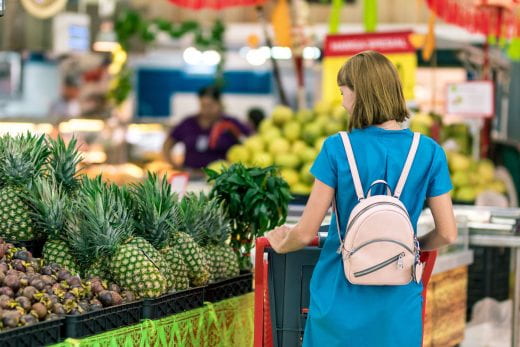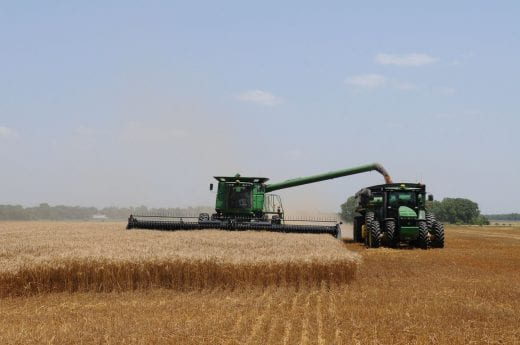In this week’s Better Kansas, we take a look at managing sugar cravings, smart grocery shopping, personal money management, basic gardening guidelines, spring wheat, and beef cattle production – in other words more events, resources and other information designed to make your life, businesses, communities and state better. This is a small glimpse of what K-State Research and Extension across the state has to offer. Share on social media and subscribe! – Mary Lou Peter mlpeter@ksu.edu
Better Living, Better Communities
 COMING OUT OF THE WINTER HOLIDAYS, it’s easy to stay in that mode where eating sweets is routine. It seems like sugar cravings beget sugar cravings. And no wonder! I’ve just learned that carbohydrates, especially sugar, stimulate the “feel good” chemical dopamine in the brain. That explains why it’s so hard to pass up that Kit Kat bar staring at me in the checkout line! Sugar-sweetened beverages are by far the greatest sources of added sugar in our diet, but plenty of other foods have added sugar, including breakfast cereals, yogurt and even my favorite pasta sauce. The article Taming Those Sugar Cravings has tips to help curb the Cookie Monster within us. One of them is to eat just a little of what you’re craving. An idea that works for me is to keep a bag of semi-sweet chocolate morsels in the pantry. When the craving hits, eat just a few of them. The fat and calories can add up fast, but still beats eating that same number of morsels in cookies. Eating a few grapes sometimes works, too.
COMING OUT OF THE WINTER HOLIDAYS, it’s easy to stay in that mode where eating sweets is routine. It seems like sugar cravings beget sugar cravings. And no wonder! I’ve just learned that carbohydrates, especially sugar, stimulate the “feel good” chemical dopamine in the brain. That explains why it’s so hard to pass up that Kit Kat bar staring at me in the checkout line! Sugar-sweetened beverages are by far the greatest sources of added sugar in our diet, but plenty of other foods have added sugar, including breakfast cereals, yogurt and even my favorite pasta sauce. The article Taming Those Sugar Cravings has tips to help curb the Cookie Monster within us. One of them is to eat just a little of what you’re craving. An idea that works for me is to keep a bag of semi-sweet chocolate morsels in the pantry. When the craving hits, eat just a few of them. The fat and calories can add up fast, but still beats eating that same number of morsels in cookies. Eating a few grapes sometimes works, too.
 HAVE YOU NOTICED THAT THE HEALTHIER FOODS at your grocery store tend to be around the perimeter of the store, while more processed foods are in the center aisles? Think fresh produce, lean meat, fresh dairy … and then think about where the cookies, cake mixes and canned foods are. Some of the ways we can shop smarter, cut down on food waste, eat healthier and save money involve planning meals ahead of time, checking what we already have on hand, and making a list before we even set out for the store. Listen to this Sound Living segment on Navigating the Grocery Store. I love the part about looking down. Check it out. And where’s that milk that we always seem to run into the store for? Typically, at the very back of the store, right?!
HAVE YOU NOTICED THAT THE HEALTHIER FOODS at your grocery store tend to be around the perimeter of the store, while more processed foods are in the center aisles? Think fresh produce, lean meat, fresh dairy … and then think about where the cookies, cake mixes and canned foods are. Some of the ways we can shop smarter, cut down on food waste, eat healthier and save money involve planning meals ahead of time, checking what we already have on hand, and making a list before we even set out for the store. Listen to this Sound Living segment on Navigating the Grocery Store. I love the part about looking down. Check it out. And where’s that milk that we always seem to run into the store for? Typically, at the very back of the store, right?!
 I GREW UP IN A WONDERFUL FAMILY, but there was never really talk about money – good, bad or ugly. And financial education? No way! So, for those of us who missed out on some of those Adulting 101 lessons, or even if you could use a refresher or reminder, take a look at the Financially $peaking page, produced by extension agents and specialists from across the state who are focused on supporting individuals and families with their financial health and wellness. I’ll be mentioning some of the nuggets they come up with from time to time, like this April 2019 article with financial tips on navigating disasters. If you find yourself buying supplies to clean up after a flood, for example, one of the key things to remember, says a FEMA official, is to save receipts from those purchases!
I GREW UP IN A WONDERFUL FAMILY, but there was never really talk about money – good, bad or ugly. And financial education? No way! So, for those of us who missed out on some of those Adulting 101 lessons, or even if you could use a refresher or reminder, take a look at the Financially $peaking page, produced by extension agents and specialists from across the state who are focused on supporting individuals and families with their financial health and wellness. I’ll be mentioning some of the nuggets they come up with from time to time, like this April 2019 article with financial tips on navigating disasters. If you find yourself buying supplies to clean up after a flood, for example, one of the key things to remember, says a FEMA official, is to save receipts from those purchases!
Better Farming, Ranching and Gardening
 WE HAVE A NEW BIG BOX LUMBER/HARDWARE STORE NOT FAR FROM WHERE I LIVE and not surprisingly on my first trip there, I was drawn to the garden section. It’s early March, but like many of you, I’m so eager to get outside and try growing new flowers and maybe some vegetables in my little postage stamp of a back yard. Over the next few months I’ll be sharing many resources aimed at helping you do everything from growing healthier lawns to pest management to pruning shrubs and more. I found this short article on Good Gardening Practices to get us started. Let the season begin!!!! (Surely, if we think it, it must be so.)
WE HAVE A NEW BIG BOX LUMBER/HARDWARE STORE NOT FAR FROM WHERE I LIVE and not surprisingly on my first trip there, I was drawn to the garden section. It’s early March, but like many of you, I’m so eager to get outside and try growing new flowers and maybe some vegetables in my little postage stamp of a back yard. Over the next few months I’ll be sharing many resources aimed at helping you do everything from growing healthier lawns to pest management to pruning shrubs and more. I found this short article on Good Gardening Practices to get us started. Let the season begin!!!! (Surely, if we think it, it must be so.)
 WE GROW A LOT OF EXCELLENT HARD RED WINTER WHEAT in Kansas – in fact it’s what we’re known for. But what about spring wheat? Our HRW wheat, which is typically planted in September or October, vernalizes (goes dormant) in the winter, and is harvested in early summer of the following year. HRW wheat often ends up as yeast breads and rolls, but is also suited for other things. About 95% of the wheat grown in Kansas is HRW. Alternatively, hard red spring wheat is planted in early spring, has a shorter growing season and does not vernalize over the winter. Its high protein and strong gluten make it a good ingredient for artisan breads, rolls, croissants, bagels and pizza crust. To help growers in northwest Kansas who may be considering giving HRS wheat a try, K-State has tested some potential varieties. Take a look at a summary of what they’ve learned and other things to consider if thinking of growing hard red spring wheat in northwest Kansas or if you just want to learn more about HRS wheat.
WE GROW A LOT OF EXCELLENT HARD RED WINTER WHEAT in Kansas – in fact it’s what we’re known for. But what about spring wheat? Our HRW wheat, which is typically planted in September or October, vernalizes (goes dormant) in the winter, and is harvested in early summer of the following year. HRW wheat often ends up as yeast breads and rolls, but is also suited for other things. About 95% of the wheat grown in Kansas is HRW. Alternatively, hard red spring wheat is planted in early spring, has a shorter growing season and does not vernalize over the winter. Its high protein and strong gluten make it a good ingredient for artisan breads, rolls, croissants, bagels and pizza crust. To help growers in northwest Kansas who may be considering giving HRS wheat a try, K-State has tested some potential varieties. Take a look at a summary of what they’ve learned and other things to consider if thinking of growing hard red spring wheat in northwest Kansas or if you just want to learn more about HRS wheat.
 FOR THOSE OF YOU IN THE BEEF CATTLE BUSINESS (there are just a few of you in Kansas, right?), this month’s Beef Tips has articles highlighting a Stock Growers Field Day on March 31 in Beloit, rules of thumb for grazing management, an estrus synchronization tool, supplementing cows during cold weather and much more. I always appreciate the Management Minute section. Much of what’s written in that segment can be applied to many workplaces besides cattle production operations.
FOR THOSE OF YOU IN THE BEEF CATTLE BUSINESS (there are just a few of you in Kansas, right?), this month’s Beef Tips has articles highlighting a Stock Growers Field Day on March 31 in Beloit, rules of thumb for grazing management, an estrus synchronization tool, supplementing cows during cold weather and much more. I always appreciate the Management Minute section. Much of what’s written in that segment can be applied to many workplaces besides cattle production operations.
_
For more resources and activities, contact the K-State Research and Extension office in your area. Check out our other blogs and subscribe to our weekly emails here: https://www.ksre.k-state.edu/news/blogs/

